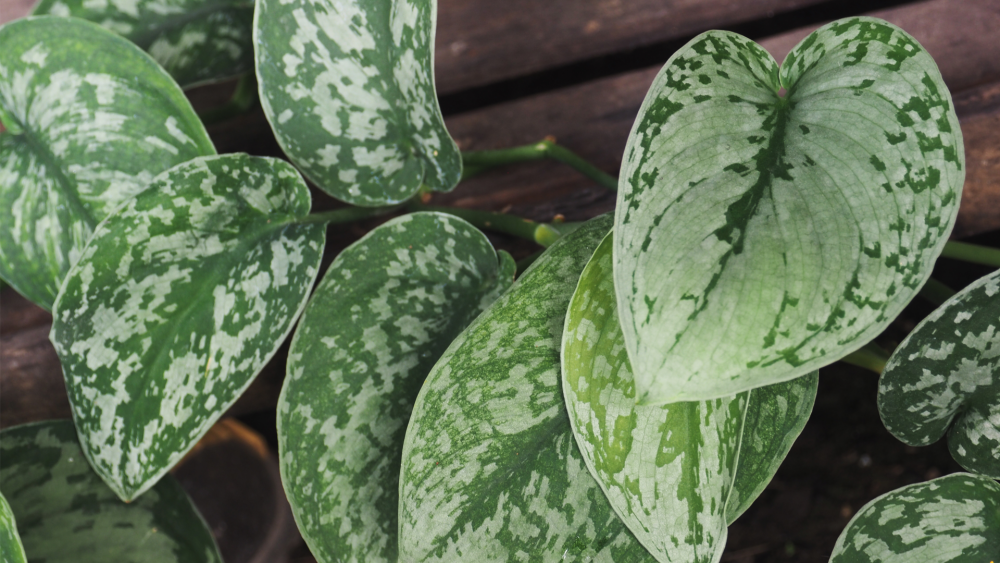
Scindapsus Silver Splash is a gorgeous, trailing houseplant known for its silvery-green foliage and velvety leaves. A variation of Scindapsus pictus, this plant is prized for its shimmering, almost metallic-looking leaf patterns that add a sophisticated touch to any indoor space. Whether you’re growing it in a hanging basket or letting it climb a moss pole, this easy-care plant will thrive with the right conditions.
Here’s everything you need to know to keep your Scindapsus Silver Splash happy and healthy!
Scindapsus Silver Splash thrives in bright, indirect light. It should be placed near an east- or north-facing window for ideal lighting conditions. Too much direct sunlight can scorch its delicate leaves, while too little light may cause slower growth and faded variegation. If you notice your plant becoming leggy with smaller leaves, it may need more light, so consider moving it closer to a well-lit area or supplementing with a grow light.
Like many tropical plants, Scindapsus Silver Splash prefers a balanced watering routine, neither too wet nor too dry. Allow the top one to two inches of soil to dry out before watering again. Use room-temperature, filtered, or distilled water to avoid harsh chemicals that may damage the plant. Reduce watering in fall and winter when growth slows down. Overwatering can lead to root rot, so always check the soil before adding more water. If the leaves become yellow and mushy, it’s a sign of excess moisture.
Scindapsus Silver Splash thrives in well-draining soil that retains some moisture but doesn’t stay soggy. A good potting mix includes two parts indoor potting soil, one part perlite or pumice for aeration, and one part orchid bark or coconut coir for better drainage. Ensure the pot has drainage holes to prevent water buildup. Repot your plant every two to three years or when the roots start growing out of the drainage holes.
As a tropical plant, Scindapsus Silver Splash enjoys warm temperatures and moderate to high humidity. It should be kept in a temperature range of 65-85°F (18-29°C) and away from cold drafts, air conditioners, or heaters. To maintain optimal humidity levels between 50-70%, consider misting the leaves occasionally, placing a humidity tray beneath the plant, or using a humidifier in drier seasons. If you notice crispy leaf edges, the air may be too dry, and increasing humidity levels can help.
Scindapsus Silver Splash is a relatively slow grower, but a bit of fertilizer can encourage lush, healthy foliage. Feed it with a balanced liquid houseplant fertilizer diluted to half strength once a month during spring and summer. Avoid fertilizing your plant in fall and winter when the plant’s growth slows down. Too much fertilizer can lead to salt buildup in the soil, which may cause brown leaf tips, so flushing the soil with water occasionally can help prevent this.
Pruning helps keep Scindapsus Silver Splash full and bushy. Trim leggy vines to promote compact growth and remove any damaged or yellowing leaves to keep the plant looking fresh. Wiping the leaves with a damp cloth every so often can help remove dust and improve photosynthesis. If you want a fuller look, pinching back the tips of new growth can encourage branching.
Scindapsus Silver Splash is easy to propagate through stem cuttings. To do this, cut a healthy vine just below a node where the leaf meets the stem. Place the cutting in water or plant it directly in moist soil. Keep the cutting in bright, indirect light and maintain humidity. Roots will develop in about two to four weeks, after which you can transfer the cutting to a pot. Propagation is a great way to expand your collection or share this beautiful plant with friends!
If the leaves start turning yellow, this is usually caused by overwatering. Checking soil moisture and ensuring proper drainage can help prevent this issue. Curling leaves are often a sign of underwatering or low humidity, so watering when the soil feels dry and increasing humidity if necessary can solve this problem. If the variegation starts fading, it may indicate low light conditions, so moving the plant to a brighter spot can restore its vibrancy. Occasionally, pests such as mealybugs, spider mites, or aphids may appear, but wiping the leaves with insecticidal soap or neem oil can keep pests at bay.
Scindapsus Silver Splash is unfortunately not pet-friendly. Like other Scindapsus plants, it contains calcium oxalate crystals, which are toxic to pets if ingested. It is best to keep it out of reach of cats and dogs to prevent accidental nibbling.